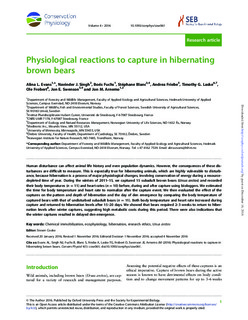Physiological reactions to capture in hibernating brown bears
Evans, Alina L.; Singh, Navinder J.; Fuchs, Boris; Blanc, Stephane; Friebe, Andrea; Laske, Timothy G.; Frobert, Ole; Swenson, Jon E.; Arnemo, Jon Martin
Journal article, Peer reviewed
Permanent lenke
http://hdl.handle.net/11250/2425471Utgivelsesdato
2016Metadata
Vis full innførselSamlinger
Originalversjon
10.1093/conphys/cow061Sammendrag
Human disturbance can affect animal life history and even population dynamics. However, the consequences of these disturbances are difficult to measure. This is especially true for hibernating animals, which are highly vulnerable to disturbance, because hibernation is a process of major physiological changes, involving conservation of energy during a resource-depleted time of year. During the winters of 2011–15, we captured 15 subadult brown bears (Ursus arctos) and recorded their body temperatures (n = 11) and heart rates (n = 10) before, during and after capture using biologgers. We estimated the time for body temperature and heart rate to normalize after the capture event. We then evaluated the effect of the captures on the pattern and depth of hibernation and the day of den emergence by comparing the body temperature of captured bears with that of undisturbed subadult bears (n = 11). Both body temperature and heart rate increased during capture and returned to hibernation levels after 15–20 days. We showed that bears required 2–3 weeks to return to hibernation levels after winter captures, suggesting high metabolic costs during this period. There were also indications that the winter captures resulted in delayed den emergence.
